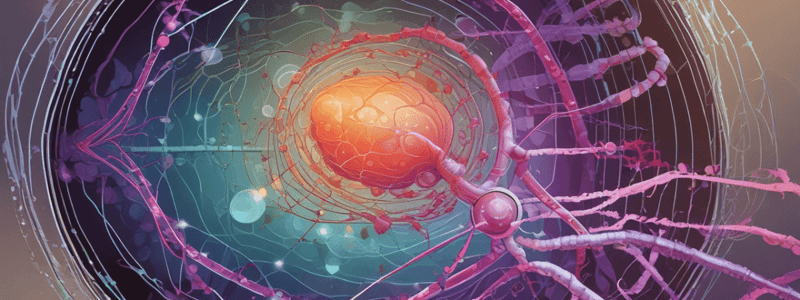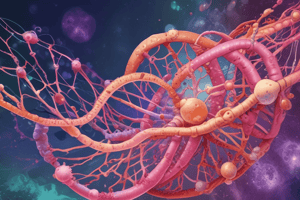Podcast
Questions and Answers
What is the main characteristic of cancer?
What is the main characteristic of cancer?
- Uncontrolled cell division
- Cell apoptosis
- Controlled cell proliferation
- Uncontrolled cell proliferation (correct)
What is the process by which tumors acquire a fresh blood supply?
What is the process by which tumors acquire a fresh blood supply?
- Metastasis
- Apoptosis
- Tumorigenesis
- Angiogenesis (correct)
What type of tumor arises in mesenchymal tissue or nervous system tissue?
What type of tumor arises in mesenchymal tissue or nervous system tissue?
- Sarcoma (correct)
- Carcinoma
- Lymphoma
- Hematopoietic malignant neoplasm
What is the primary basis of carcinogenesis?
What is the primary basis of carcinogenesis?
What is the term for the spread of cancer cells to distant body sites?
What is the term for the spread of cancer cells to distant body sites?
What is the term for tumors that originate in epithelial tissue?
What is the term for tumors that originate in epithelial tissue?
What is the term for the process of tumor formation?
What is the term for the process of tumor formation?
What is the term for tumors that arise in cells of hematopoietic lineage?
What is the term for tumors that arise in cells of hematopoietic lineage?
What is the primary function of growth factors in cell growth regulation?
What is the primary function of growth factors in cell growth regulation?
What occurs when a cell accumulates mutations in the regulation of cell growth and differentiation?
What occurs when a cell accumulates mutations in the regulation of cell growth and differentiation?
According to the two-hit theory of carcinogenesis, how many damaged alleles are required for a cell to initiate a tumor?
According to the two-hit theory of carcinogenesis, how many damaged alleles are required for a cell to initiate a tumor?
What type of genes can inhibit cellular proliferation?
What type of genes can inhibit cellular proliferation?
What is the role of signal transduction molecules in cell growth regulation?
What is the role of signal transduction molecules in cell growth regulation?
What is the term for the genes that can activate cellular proliferation?
What is the term for the genes that can activate cellular proliferation?
What can occur in a non-predisposed fetus to produce sporadic cancer?
What can occur in a non-predisposed fetus to produce sporadic cancer?
Why is it important to understand mutated genes that are inherited in families?
Why is it important to understand mutated genes that are inherited in families?
What can occur in germline cells leading to the transmission of cancer-causing alleles?
What can occur in germline cells leading to the transmission of cancer-causing alleles?
What is the primary basis of carcinogenesis?
What is the primary basis of carcinogenesis?
What can environmental factors alter in carcinogenesis?
What can environmental factors alter in carcinogenesis?
What is an example of a carcinogen?
What is an example of a carcinogen?
Why do different populations exhibit varying cancer frequencies?
Why do different populations exhibit varying cancer frequencies?
What can be identified in individuals with a family history of cancer?
What can be identified in individuals with a family history of cancer?
What is the relationship between genetics and environment in cancer risk?
What is the relationship between genetics and environment in cancer risk?
What can examination of genetically similar populations under differing lifestyles reveal?
What can examination of genetically similar populations under differing lifestyles reveal?
What is the primary function of tumor suppressor genes?
What is the primary function of tumor suppressor genes?
What is the origin of most oncogenes?
What is the origin of most oncogenes?
How do retroviruses contribute to the formation of tumors?
How do retroviruses contribute to the formation of tumors?
What is a characteristic of tumor cells?
What is a characteristic of tumor cells?
What is a result of defective repair of double-stranded breaks in DNA?
What is a result of defective repair of double-stranded breaks in DNA?
What is the role of tumor suppressor genes in cell growth?
What is the role of tumor suppressor genes in cell growth?
What is the effect of a single copy of a mutated oncogene?
What is the effect of a single copy of a mutated oncogene?
What is the result of faulty DNA mismatch repair?
What is the result of faulty DNA mismatch repair?
Flashcards are hidden until you start studying
Study Notes
Cancer Overview
- Cancer is a prevalent and deadly disease affecting millions worldwide, accounting for approximately one in four deaths.
- More than half of the population is expected to be diagnosed with invasive cancer in their lifetime.
- Cancer arises from a combination of environmental exposures and genetic mutations.
Tumorigenesis
- Tumorigenesis involves pivotal processes, such as:
- Heightened growth signals
- Resistance to growth-inhibiting cues
- Evasion of apoptosis
- Tumors necessitate a fresh blood supply acquired through angiogenesis.
- Malignant tumors infiltrate nearby tissues and disseminate to distant body sites (metastasize).
Types of Tumors
- Tumors are categorized based on their tissue of origin, including:
- Sarcomas (mesenchymal tissue, bone, muscle, or connective tissue, or nervous system tissue)
- Carcinomas (epithelial tissue, such as the cells lining the intestine, bronchi, or mammary ducts)
- Hematopoietic and lymphoid malignant neoplasms (leukemia and lymphoma, arising in cells of hematopoietic lineage, including bone marrow and the lymphatic system)
Single-Origin Cells
- Tumor cells typically originate from a singular ancestral cell, forming a monoclonal population.
Causes of Cancer
- Genetic alterations of cell regulatory systems are the primary basis of carcinogenesis.
- Cancer can be induced in animal models by damaging specific genes.
- Introduction of normal copies of damaged genes can reverse a cancer phenotype in cell culture systems.
Genetic Alterations in Carcinogenesis
- Cancer-predisposing mutations can occur in germline cells, leading to transmission of cancer-causing alleles from one generation to the next.
- Families with high incidence of specific cancers demonstrate the inheritance of damaged genes causing cancer.
- Identification of individuals at elevated risk allows for more intensive screening of high-risk groups, leading to better prognoses, reduced morbidity, and mortality rates.
Environmental Considerations
- Genetic alterations in cell regulatory systems are the primary basis of carcinogenesis.
- Frequency and consequences of mutations can be altered by environmental factors.
- Interaction of genes with the environment plays a key role in determining carcinogenesis.
- Different populations exhibit varying cancer frequencies, suggesting environmental and genetic influences.
Cancer Genes
Genetic Control of Cell Growth and Differentiation
- Cancers arise from clones of cells losing normal growth and differentiation controls.
- The regulation of cell growth is accomplished by substances that include:
- Growth factors that transmit signals from one cell to another
- Specific receptors for the growth factors
- Signal transduction molecules that activate a cascade of phosphorylating reactions within the cell
- Nuclear transcription factors
- Mutations can occur in any of the steps involved in regulation of cell growth and differentiation.
The Inherited Cancer Gene Versus the Somatically Altered Gene
- The two-hit theory of carcinogenesis states that a cell can initiate a tumor only when it contains two damaged alleles.
- A person who inherits one copy of a mutant gene must experience a second, somatic mutation in one or more of that gene in order to develop cancer.
Major Classes of Cancer Genes
-
- Inhibit Cellular Proliferation: Tumor Suppressor Genes
- Class of genes that play a crucial role in regulating cell growth and preventing the development of cancer.
- These genes act as "brakes" on cell division and proliferation, helping to maintain the normal function and integrity of cells.
- When tumor suppressor genes are mutated or inactive, they lose their ability to control cell growth effectively, leading to uncontrolled cell division and the formation of tumors.
-
- Activate Proliferation: Oncogenes
- Most oncogenes originate from proto-oncogenes.
- Oncogene develops from mutations in any of the four basic regulators of normal cell growth (growth factors, growth factor receptors, signal transduction molecules, and nuclear transcription factors).
- A single copy of a mutated oncogene is required to contribute to the multistep process of tumor progression (Dominant).
-
- DNA Repair Genes, Chromosome Integrity, and Tumorigenesis
- Tumor cells typically are characterized by widespread mutations, chromosome breaks, and aneuploidy (genomic instability).
- Genomic instability can occur because of defects in the proteins required for accurate cell division or in proteins responsible for DNA repair.
- There are a number of ways various types of genomic instability can give rise to cancer.
Studying That Suits You
Use AI to generate personalized quizzes and flashcards to suit your learning preferences.




